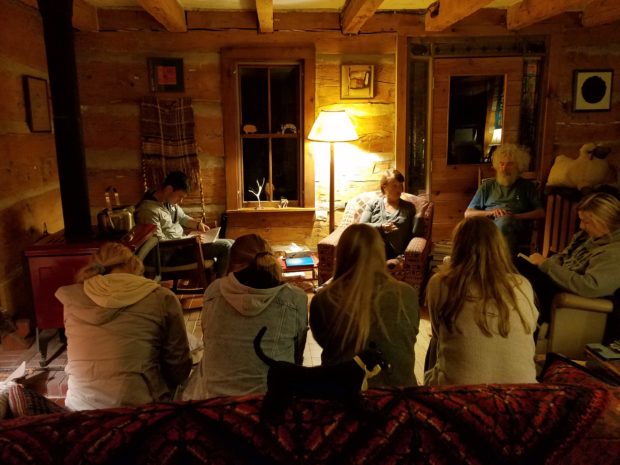
Knight Center for Environmental Journalism students interview Eugene Bourgeois and Marti McFadzean, leaders of two Kincardine, Ontario, organizations opposing the Deep Geological Repository, a nuclear waste storage facility proposed at the site of Bruce Power. They met in the cabin Bourgeois built from reclaimed timber. Image: David Poulson
By David Poulson
I had tried for weeks to arrange a meeting of my environmental journalism students and First Nations officials during a field reporting trip to Kincardine, Ontario.
I came close. But now things were falling apart. Just before we hit the road last semester, tribal officials phoned to say they decided not to meet with us to talk about a controversial radioactive waste disposal plan on Lake Huron’s Bruce Peninsula. They wanted to assess their community’s reaction to the plan before speaking about it with outsiders.
Our three-day Canadian roadtrip was part of a Knight Center environmental journalism class on transboundary issues. The plan was to directly learn of some of the environmental challenges that the U.S. shares with Canada. At the same time, the half-dozen students would gather ideas and sources for classroom assignments and for our center’s news service which carries stories relevant to the eight states and two provinces bordering the Great Lakes.
This is the second year of support from Michigan State University’s Canadian Studies Center for a program that gets journalism students off the phone for a true taste of field reporting.
And now they were getting it: A key source, initially interested in helping out, declined to meet with us.
So, we did what journalists do. We pushed on.
Good thing. Our hits far exceeded our misses. We stopped for lunch at a small restaurant in Grand Bend, Ontario, shortly after entering Canada. A student who had just written a story about growing concern over plastic straw litter noted that the drinks here came with paper straws. When the owner overheard heard our conversation, he told us that he’d been supplying customers with paper straws for years. He got them from a friend in Great Britain and they cost him 14 cents each, he said. But the visitors to this Lake Huron resort community appreciated them and it proved to be a business decision well worth the cost.
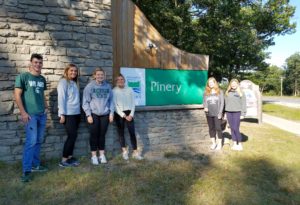
MSU students at Canada’s Pinery Provincial Park. From left, Remington Sawade, Kaley Fech, Ninna Biondo, Quinn Zimmerman, Alexandria Iacobelli, Whitney McDonald. Image: David Poulson
And then, as often happens when journalists engage directly with real people, the conversation took an unexpected turn.
When he learned the purpose of our trip, the owner told us that when he was a soldier in the British army he counted endangered plants at military target ranges for a university study. No one builds houses in firing ranges, so lots of rare plants thrive at them, he explained.
When I pointed out that perhaps explosives are not the best thing for the survival of rare plants, he disagreed. Explosives create “edge” environments where unusual species thrive, he said. “You ought to do a story about that.”
Then he asked, “Do you know how to count penguins?”
He did.
He once was deployed to the Falkland Islands to do just that. You sit real still until they think you’re one of them, he said. When they gather around, you count them with the aid of a species identification key.
Later, in the van enroute to our next stop, we unpacked that conversation. The paper straw anecdote would have been a perfect lead to the story about the declining popularity of plastic straws, I told the students. And the firing range tale and the penguin-counting are unlike any military operation I had ever heard about. They were the kinds of things that with further investigation you could build good stories around.
That’s why good reporters get out of the office and talk to real people, I said. The lesson hit home.
“The Canada trip was helpful for me to see other ways to retrieve stories outside of just searching on the internet,” Alexandria Iacobelli, a graduate student in health risk communications, later recalled. “I am new to journalism courses and it was great to fully immerse myself in different journalism experiences. I enjoyed getting to hear different viewpoints of the same story, especially from people who were passionate about what they believed.”
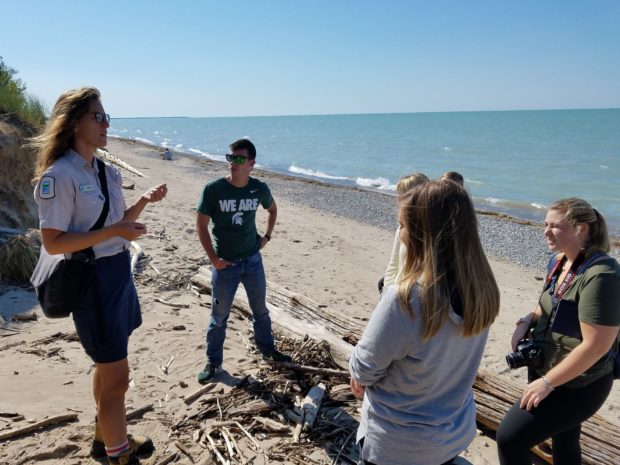
Michelle Polley, a naturalist at Pinery Park in Ontario, discusses skinks, toad balloons, marram grass, hognose snakes and karner blue butterflies with Knight Center students on a Lake Huron beach in Canada. Image: David Poulson
Another reason for getting students out of the classroom – and reporters out of the newsroom – is to see the resources they’re reporting about. We hiked the Lake Huron shoreline across from the one most of us knew well in Michigan. A provincial park naturalist explained how similar the endangered and invasive species are on both sides of the lake. In fact, in one conservation initiative Ontario swapped some of its moose for some of Michigan’s turkeys decades ago.
How’d that work out long-term, we asked.
“I don’t know,” she replied.
Hmmm…we wondered if this was a story to follow up on when we returned home. We knew we had moose in Michigan. How were our turkeys doing in Canada?
While we didn’t get the First Nation perspective on nuclear waste disposal at Kincardine, we did meet with anti-nuclear power activists there. The students left that meeting worried about nuclear waste storage and armed with questions for Bruce Power officials at the nuclear plant we toured for half of the next day.
Primed by the critics we met the night before, the students were skeptical about nuclear power and the storage of its waste before the tour. After it, they were confused. Bruce Power officials had good answers.
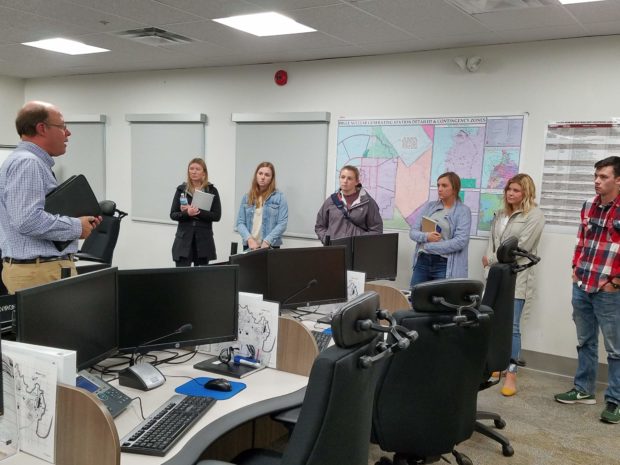
Christopher Mercanti, manager of community and indigenous relations for Bruce Power, meets in the nuclear power plants command center with Knight Center students. Image: David Poulson
So, is the underground storage of nuclear waste a good idea? We had been inundated with so much conflicting information that it was a tough call.
Could further reporting resolve such conflicts? If it couldn’t, how do reporters responsibly present such questions to the public in way that is fair, accurate and helpful? Journalists face such questions all the time, and it was good to give students a taste of wrestling with them.
By happenstance we learned of a nearby seven-acre greenhouse for growing medicinal marijuana that was expanding into the recreational market on the eve of Canada’s decriminalization of pot. Coincidentally, Michigan voters at the same time were facing a ballot initiative to do the same thing back home. With a gap in the schedule from the last-minute First Nations cancellation, I called and asked for a tour. I was told that with needed security clearances and construction underway, it would take weeks to arrange one. I should send an email to set one up.
But we were there now. I drove out to the farm. We talked ourselves past a construction worker, a security guard and one company official before convincing another to talk to us in the parking lot. Her irritation at our arrival in the middle of their expansion disappeared as we asked about the environmental implications of growing pot on a commercial scale. The place uses integrated pest management to control harmful insects, carbon dioxide to increase production, plant material as compost for local farmers and genetically superior seeds from the Netherlands, she said.
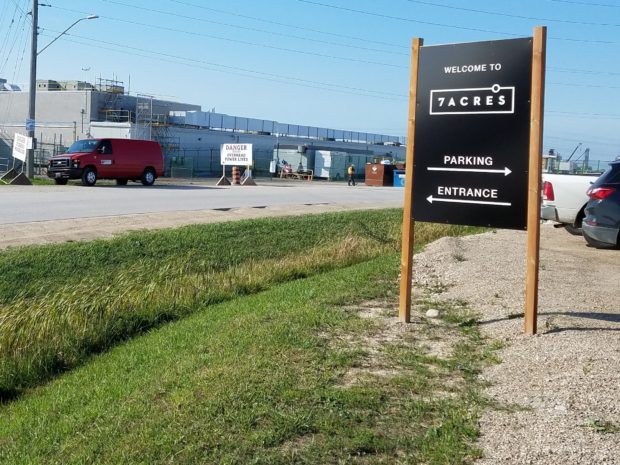
The 7Acres commercial marijuana farm near Kincardine, Ontario, gears up to handle recreational demand after Canada’s nationwide decriminalization of the plant. Image: David Poulson
Good stories, but more important were the lessons about journalism: Take advantage of unexpected opportunities. Be persistent.
On the way home, we met with Sarnia Mayor Mike Bradley, Ontario’s second longest-serving mayor. His city, directly across the St. Clair River from Port Huron, Michigan, is one of North America’s largest petroleum processing centers. Although the industries affiliated with that work polluted the river in the past, Bradley told us of the cleanup and the environmental precautions that have since taken place. It’s time to consider when the area could be removed from a list of the region’s pollution hot spots that the U.S./Canada International Joint Commission long ago identified, he said.
But the First Nations environmental officials we later met downriver of Sarnia on Walpole Island disagreed. Cleaning up decades of pollution is a multi-generational challenge, they said.
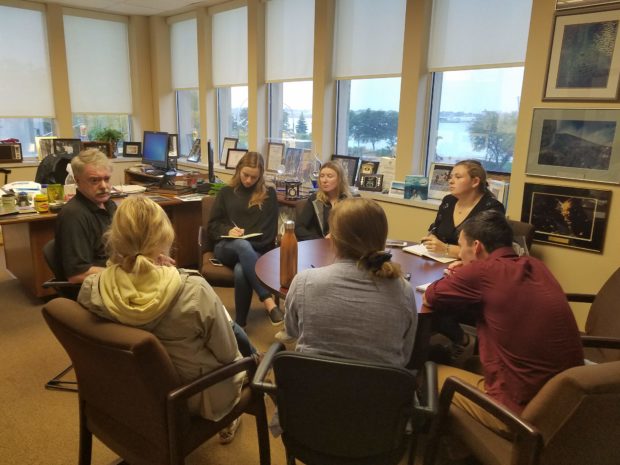
Sarnia Mayor Mike Bradley discusses his city’s environmental challenges with MSU students. Image David Poulson
Their perspective emphasized that Canada and the U.S. aren’t the only nations sharing environmental challenges in our region. It was a perspective that later in the semester prompted a student to write about a poll showing the greater environmental awareness of indigenous people.
One First Nations official gave us a different perspective on phragmites, a much-reviled invasive plant that chokes out native wetland vegetation. During a series of community meetings, elders on Walpole Island asked if the plant might be here for a reason, he said.
A student later resurrected that observation for a story about the plant’s productive potential, including its use as a biofuel.
We finished the trip with a tour of the end of Line 5, the controversial pipeline carrying petroleum from western Canada through Michigan and back into Sarnia for processing. The aging pipeline is controversial because it crosses under the water separating Michigan’s Upper and Lower peninsulas. Critics worry that a rupture there will pollute the Great Lakes.
But little media attention is paid to where it crosses the St. Clair River from Michigan to Ontario where we visited. Officials with Enbridge, the pipeline owner, showed us around, described planned improvements to the crossings and made the case for why such crossings are safer now, even after a highly publicized spill several years ago on Michigan’s Kalamazoo River.

Enbridge’s controversial Line 5 petroleum pipeline ends in Sarnia. Image: David Poulson
They also arranged a tour of one of the local refineries that depend on petroleum delivered by Line 5 and other pipelines. If refining stopped in Sarnia, Toronto gas stations would be dry within two weeks, our guide said.
It was a perspective often not as evident in the pipeline political news coverage that is the source of what most students know of the issue.
As I had hoped, the field experience yielded sources and story ideas. Some we wrote. Some we published. Some other students will pursue this semester.
“It helped me write my stories in your class throughout the semester and gave us an opportunity to report in a new location,” journalism student Whitney McDonald said later. “That is an experience that most journalists don’t get until they are in the field working on their own.
“During our last story, months later, I am still in contact with some of our connections from Canada, such as Mayor Mike Bradley and Naomi Williams from Walpole Island,” she said. “I am confident that I wouldn’t have produced the stories I did this semester without this trip.”
Perhaps more important, the trip gave journalism students experience with the frustrations and the opportunities offered by on the ground reporting.
I often urge journalists to get out of the newsroom and into the field.
That’s good advice for journalism educators, too.
David Poulson is the senior associate director of the Knight Center for Environmental Journalism at Michigan State University.
|
|
